All of what is reported below was accomplished after only one year of cover crops. This work was inspired by a conversation Don and I had last winter with Dr. Eileen Kladivko from Purdue University. As I say in cover crop meetings,
Don’t expect a miracle the first year – but look for one.
Over the exceptionally dry and super hot late-spring/summer months of 2012 my brother Don Robison collected “plant-health” related data on our corn field at Robison Farms near Greenwood, IN. Don took data on the corn from each area of the cover crop plot we planted last fall over the top of a soybean field as well in the “check area” (no cover crop area).
The data he took throughout the summer included plant chlorophyll readings, plant height, and compaction readings. I presented some of the chlorophyll data on the CropLife Webinar and at several cover crop meetings this summer (and more is posted below).
On August 15th Don and I took hand harvested yield checks from each area and from the check area. The data on the corn yield was almost identical to what we found with the chlorophyll data and compaction data. Where we had the healthier plants all season long (more “green-ness” and deeper roots) we had higher yields.
To figure yield we utilized this formula we found at a Purdue University agronomy website.
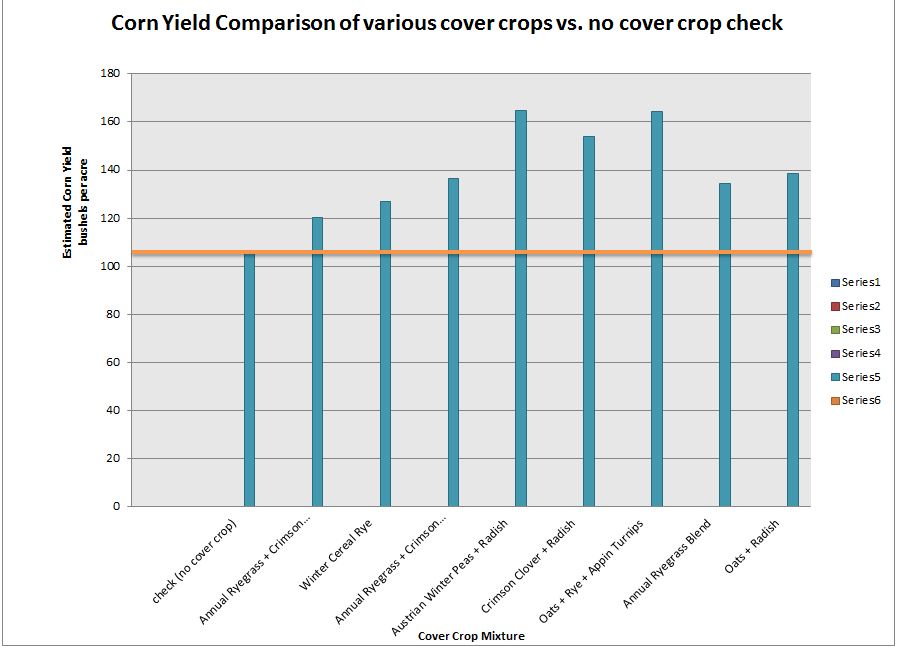
The area where the plot was had a 24″ water line was installed by the county in 2009; so it was intended to be a “rescue disturbed soil trial”. The corn was not harvested directly over the water line but it was where the soil from the water line was mixed in with the top soil. In 2011 the field was in Soybeans and yielded 48 bushels/acre. In 2010 the field was corn and yielded 198 bushels/acre. The whole field has been no-tilled for most of the past 20 years (there were some years with conventional tillage done – mainly in the early 90’s). 175 Units of N were applied (100 units (28%) with the chemical burn down application early season and 75 units side dressed (28%) in early May).
Rainfall from May 1 to July 31 was 2.24″ (with only 0.75 from May 1 to July 19). There were 42 days over 90 degrees and 8 days over 100 degrees during that time. All time record dry and heat was recorded in July, 2012 in the area.
Don took chlorophyll readings weekly (one week missed in July due to a family vacation). He took 30 chlorophyll readings per plot per sampling date. He also took multiple plant height readings each time as well. He followed the manufacturers instructions on the chlorophyll readings and penetrometer tests. Don spent a lot of time in this field so we could all have this data! Thanks to The CISCO Companies for providing the seed, equipment, and Don’s labor to collect this data.
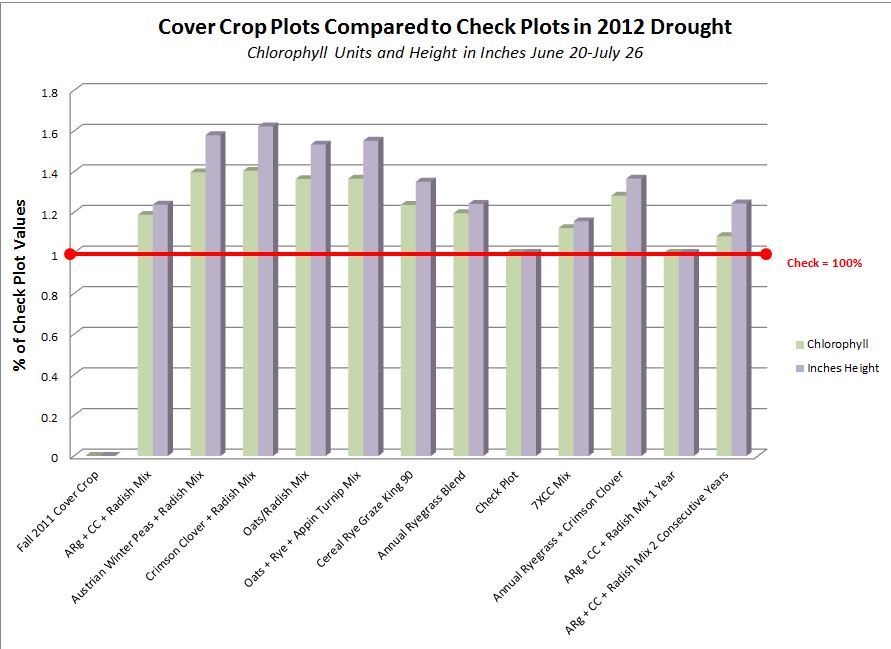
Observations:
- The plot areas that rated healthier (more green-ness and taller) yielded the best.
- The plots areas where there was less compaction yielded the best
- The plots with annual ryegrass did not fare as well as some others in this drought year – yet was still considerably above the check.
- Not all plots with radish were “top” yielding – however two of the top three yielding plots had legumes plus radish.
- Plots with legumes were generally healthier all season long and their yield reflected that.
- I doubt that the whole field will average over 100 bushels/acre. As with all hand yield tests they are estimates but I believe that the comparison is very accurate.
- The Austrian Winter Peas, Crimson Clover, and Appin Turnips overwintered “beautifully” and were growing aggressively when sprayed at burndown.
- There was a considerable amount of earthworm activity in the cover crop area but only a few earthworms were found in the “check” area. That is unfortunate because 2 acres were covered and 48 acres were not!
- There were more corn roots in the plot areas we dug vs. the check area (watch for a new post coming on this soon).
- There was more moisture in the soil where the cover crop plots were compared to the check area.
- The soil structure was considerably better in each cover crop plot vs. the check area.
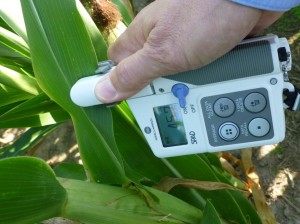
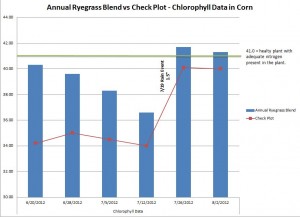
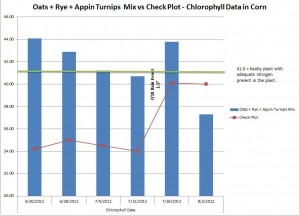
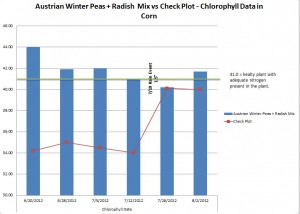
Dave, I have a dryland mixed silty clay loam/sand farm that I have cover cropped continuously since 2007 after corn and beans with either winter wheat, cereal rye, or a cereal rye/ radish/rapeseed or cereal rye/austrian winter pea/hairy vetch cocktail. We’ve received 1.29″ of rainfall from May 29 til now, with 8.82 inches for the year to date.
I was out walking in it last weekend and just wandering around picking a few ears and was surprised to see as many ears as I did with the quality there was. There is 30 acres of 20 year CRP land that has been cropped once with soybeans with rye cover crop behind it that was even more surprising. I am eager to get the combind out there just to see what kind of yield will be there in this record low rainfall year. It will all be crop insurance or below I’m very sure but even 25 bushels with this rainfall ytd would be amazing to me.
I work with NRCS as a No-till Specialist and have no-tilled continuosly for 21 years with cover crops since 2005.
Dan Gillespie
I’m sorry I forgot to say I live and farm in Madison County, NE in the northeast corner of the state.
Dan
hidave/ i have been no tilling and using cover crops for 12 plus years and every year we have a dry spell my corn and beans have no problem. last year i planted a group 3.5 bean and i had 149 pods per plant in 7 in no till drilled we didnt receive any rain in august.and they yielded 58 bushel per acre.this year my corn and beans recieved no rain from june 1 till july 24. i am looking at better corn and bean yields this year.i believe ill push 180 bu of corn and upwards of 65 of beans.we should get cheaper insurance from the crop insurance companys.i have quit buying insurance because because no till and cover crops take care of you. organic matter has kept going up and is now 3 4 and 5%
Great work Don and Dave, This kind of data takes a lot of time but is VERY valuable to all of us. The results are very similar to what we have seen on our farm in much less scientific tests. If you have the opportunity I would love to see the same covers in the same places for multiple years. I think the more grass based systems have advantages for long term use versus single season plant health responses for legumes and radish. We have managed this by putting legumes and radish ahead of no-till corn and rye/ryegrass ahead of soybeans. I think the long term rotation is really helping. Thanks again.
Thanks for the news to both Rodney and Larry, two of the guys I look up to a whole bunch as “pioneers” in the cover cropping realm. Rodney , Don and I plan on seeding the same mixes in the same plots again and checking on the soybean health next year, then trying again the third year with the same mixes again before corn and seeing what difference we see. The hard part is that Dad wants to put cover crops on all of his acres now! Just like you he no longer wants to leave check strips and lose yield! We’ll see if we can get the pilot to skip a full 50-55 feet and that will give us 6 rows w/o a cover crop through the whole field (the other area of the 50-55′ will be our plot area.
What were your seeding rates for each? Could not find that in either posting.
The ARg/Crimson/Radish mix was 21#/acre. The Crimson/Radish mix was 20#/acre. The Pea/Radish Mix was 35#/acre. The Oats/radish was 2 bu oats + 5# Radish/acre. The Oat/Rye/Turnip mix was 105#/acre. The Cereal Rye was 1 bu/acre. The ARg/Crimson Mix was 20#/acre. The ARg Blend was 20#/acre.
Dan, this is a great testimonial. Please let me know how your crop turns out when you harvest it! Dave
I live on 5 acres 10 mi N of Williamsport IN. The back 4 acres have been farmed in corn & soy with chemicals for years. I’m going to divide into 2 acre for pasture,1 acre for produce & 1 acre for feed. I will be gone on a job next year. What can I plant as a cover crop to sustain the land through this winter into next summer & winter that would be good to add organic matter the following spring to start planting.
Dan, Wow, you have am interesting question. I would use 8#/acre medium red clover, 25#/acre meadow fescue (not tall fescue), and 2#/acre ladino clover. When you get back you will have a pasture established on the 2 acres and a nice hay crop on the other acre. In the produce are you should have a very nice green manure to turn over. Get this planted right away for best success. Plant it 1/4″ deep in a nice clean, firm seedbed.